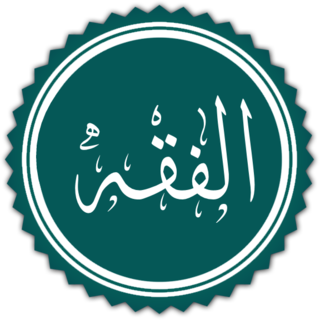
The National Monument is a 132 m (433 ft) tower in the centre of Merdeka Square, Central Jakarta, symbolizing the fight for Indonesia. It is the national monument of the Republic of Indonesia, built to commemorate the struggle for Indonesian independence.
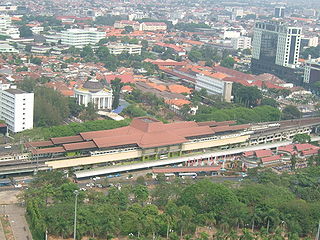
Gambir is a subdistrict of Central Jakarta, Indonesia. It is characterized by many historic buildings from the colonial era. Gambir Subdistrict is the location of many political and administrative center of Jakarta and Indonesia. The Merdeka Palace, the National Museum, the headquarters of the Indonesian Scout Movement and the Merdeka Square are located in Gambir.

Tambora is a subdistrict of West Jakarta, Indonesia. Tambora Subdistrict is bounded by a railway to the west and to the north, Kali Krukut - Kali Besar canal to the east, and Duri Selatan Road to the south.

Sukabumi Regency is a regency (kabupaten) in southwestern Java, as part of West Java province of Indonesia. The regency seat is located in Palabuhan Ratu, a coastal district facing the Indian Ocean. The regency fully encircles the administratively separated city of Sukabumi. Covering an area of 4,161.00 km2, the regency is the largest regency in West Java and the second largest regency Java after the Banyuwangi Regency in East Java. The regency has a population of 2,434,221 with a large part of it living in the northeastern part of the regency that encircles Sukabumi City, south of Mount Gede. A plan to create a new regency, the North Sukabumi Regency is currently waiting for the approval of the central government.

Cilincing is a historic neighborhood in the northern coast area of Jakarta, Indonesia. The neighborhood is sandwiched between the Port of Tanjung Priok to the west and River Titram to the east. Cilincing was made one of the subdistrict of North Jakarta, encompassing a huge area which includes Marunda and the non-coastal hinterland.
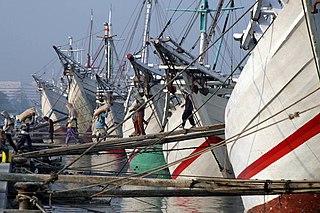
Sunda Kelapa is the old port of Jakarta located on the estuarine of Ciliwung River. "Sunda Kalapa" is the original name, and it was the main port of Hindu Sunda Kingdom of Pajajaran. The port is situated in Penjaringan sub-district, of North Jakarta, Indonesia. Today the old port only accommodate pinisi, a traditional two masted wooden sailing ship serving inter-island freight service in the archipelago. Although it is now only a minor port, Jakarta has its origins in Sunda Kelapa and it played a significant role in the city's development. The port is currently operated by the state-owned Indonesia Port Corporations.

Gereja Sion is a historic church located in Pinangsia Administrative District, Taman Sari, Jakarta, Indonesia. Dating from 1695, it is the oldest church still standing in Jakarta.
Taman Ismail Marzuki, popularly known as TIM, or in English as Ismail Marzuki Park, is an arts, cultural, and science center located at Cikini in Jakarta, Indonesia. Within the complex there are also educational institutions such as the Jakarta Arts Institute (IKJ), the HB Jassin Literary Documentation Center and Jakarta Planetarium. The complex is built on an 8 hectares land area. TIM is named after Ismail Marzuki, one of Indonesia's most influential composers. Taman Ismail Marzuki complex comprises a number of facilities including six performing arts theaters, cinemas, an exhibition hall, a gallery and an archive building. The complex was previously known as Jakarta Arts Center.
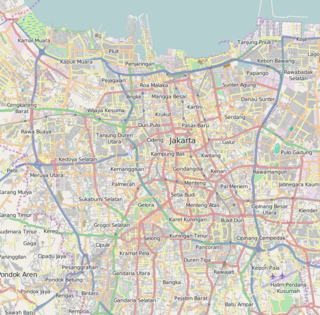
Vihara Bahtera Bhakti is a Chinese-Buddhist temple located in Jakarta, Indonesia. The Chinese shrine, or klenteng, is located in the neighborhood of Ancol, hence it is more popularly known as Klenteng Ancol. It is dedicated to Da Bo Gong, a deity of land and wealth, and his wife. Established ca. 1650, it is one of the oldest Buddhist temple in Jakarta.
Pieter Adriaan Jacobus "Piet" Moojen was a Netherlands-Indies architect, painter and writer. He studied architecture and painting in Antwerp. He lived and worked in the Dutch East Indies from 1903 to 1929. He was one of the first architects to implement Modernism in the Dutch East Indies. Moojen became widely known for his work on the Dutch entry at the Paris Colonial Exposition in 1931. He was active as an architect between 1909 and 1931.
Sumedang Larang was an Islamic Kingdom in western Java. Its territories consisted the Parahyangan region, before it became a vassal state under the Mataram Sultanate.
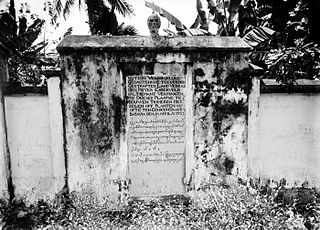
Pieter Erberveld was a Eurasian resident of Batavia, Dutch East Indies, the headquarters of the VOC in Asia, during the 17th and early 18th centuries who was accused of plotting a rebellion with Javanese for January 1, 1722, but was captured and executed, and a monument erected where his house had stood.

Angke Mosque, officially known as Masjid Jami Angke or Masjid Al-Anwar, located at Tambora, Jakarta, Indonesia. It is one of the oldest mosques in Jakarta. Well-maintained and retaining its original form, the mosque has been called by the historian Denys Lombard as 'une des plus élégantes de la vieille villa'. The history of the mosque reflects the multiethnic and multilayered origin of colonial Jakarta

Cikini Hospital, also known as PGI Cikini Hospital, Rumah Sakit Cikini, is a hospital in Cikini, Menteng in Jakarta, Indonesia. It was formerly a mansion that was designed by Indonesian painter Raden Saleh, who used it as residence. Use of it as a hospital and nursing academy began in 1898. The building was built in 1852 and is known for its park-like setting in busy Jakarta, and was home to antelope until they were removed in the early 1970s. Saleh once had a collection of wild animals on the property. It has design features similar to the Callenberg Castle.

Al-Azhar Great Mosque is a mosque located in Jalan Sisingamangaraja, Kebayoran Baru, Jakarta. The mosque was constructed between 1953 and 1958. It was originally known simply as Mesjid Agung. It was Jakarta's largest mosque when it was built until it was surpassed by the Istiqlal Mosque which was completed in 1978. Al-Azhar mosque and the mosque complex is best known for its educational works.
Gedong Tinggi Palmerah is an 18th-century Dutch Indies country house located in Jakarta, Indonesia. The building is among the protected colonial heritage of Indonesia. Like many other colonial country houses of Jakarta, despite its protection by the government, the lack of interest in the study of the building caused it to slowly fall into disrepair. It was converted into a police station.
Mona Lohanda is an Indonesian historian, archivist and academic, as well as a former curator of the National Archives of Indonesia. She is a leading authority on the history of Batavia, as well as its Chinese-Indonesian community.
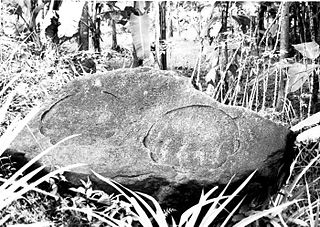
Kebon Kopi I also known as Tapak Gajah inscription, is one of several inscriptions dated from the era of Tarumanagara Kingdom circa 5th century. The inscription bearing the image of elephant footprint, which was copied from the elephant ride of King Purnawarman of Tarumanagara, which is equated with Airavata, the elephant vahana (vehicle) of Indra.





